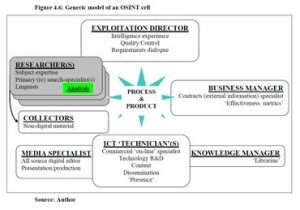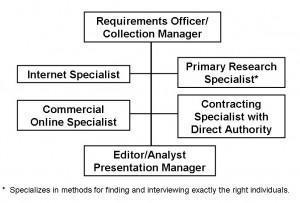1- OSINT definitely relates to HUMINT to the extent that it involves an analyst's presence of mind. Primary data on OSINT (govt docs) are old and hardly any attention has been paid to cybersecurity, safer communications. Also, Open Source Info has increased tremendously over the years calling ICT engineers to research and produce more upon technology that helps in faster collection, analysis and dissemination. We fail to realise that an area specialist or language expert may not the grab the nitty-gritty science ICT fast. In this regard please tell whether the collection and analysis of OSINT needs to be done by different experts or by the same analyst.
First, you are completely missing the fact that OSINT is HUMINT not because of the analyst but because 90% or more of the open sources are not online, not in English, and not accessible to standard collectors including diplomats and spies, under their present construct.
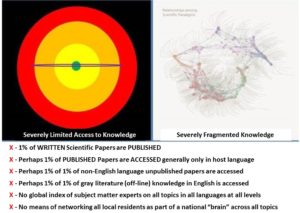
My second graduate thesis examined three Embassies I was very familiar with and determined that we collect at best 20% of what is relevant and available, and spill 80% of that in how we return it to our home country — hence we are operating with at best 2% of the relevant available analog information — compound that with our processing no more than 1% of what we have in digital form and you can see how very shallow and irresponsible our approach to global information have been, is now, and will for the foreseeable future absent an Open Source Agency and a complete redirection of the existing secret world that is 70% waste and produces no more than 4% of what the President needs (and nothing for everyone else).
It is important to distinguish between OSINT and OSIF. Almost everything is open source data or open source information (for example, anything that is of generic interest is OSIF, not OSINT). OSINT answers a specific question from a specific commander or customer. No one in the USA does OSINT per se, they just process OSIF and vomit it into the system.
You do focus on one very important point: the collection and analysis of OSINT in any given domains needs to be done by Subject Matters Experts (SMS) and you will see that in the below diagram, they are an important slice. OSIF can be collected by every type of human, and the distinctions among the previously illustrated fifteen slices of HUMINT and the eight tribes of OSIF are important.
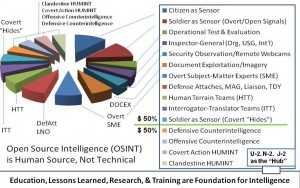
If I were in charge of the all-source intelligence endeavor, the analysts would be mature officers hired only after having proven themselves as published, cited, and deeply immersed in their respective OSIF arenas — today we rely on children spoon fed secrets, deprived of OSIF, who go through the motions. Nobody is holding the secret world accountable for being stupid & wrong.
I cannot stress enough that any OSINT endeavor that limits itself to what is available online is corrupt as well as largely useless.
2- Throw some light on the role of think tanks in OSINT? Think tanks have been missing from the Information Commons.
Think tanks have not been missing from the information commons, they are included in the eight tribes, generally as part of academia but they can also be found within government, commerce, and non-governmental. As a general rule think tanks are largely worthless because they have a fixed stable of experts educated, generally badly, decades before, and they do not have access to multilingual human sources and data sources — they tend to work in their primary language and they tend to be advocacy oriented rather than discovery and decision-support oriented.
3. Please comment of the aptness of the following model from the perspective of any intelligence agency.
Source: Gibson-PhD-Thesis-on-OSINT 2007
Mr. Gibson mis-appropriated my work and also failed to attribute the entirety of his PhD to my work — many of his sources appear to be from among those that I organized in my international OSINT conference from 1992 until 2006 when the conference was stolen from me by Eliot Jardines, a former Army sergeant and because he was not me and harmless, the short-lived Associated Deputy Director of National Intelligence for OSINT, with the explicit approval of James Clapper, then the DNI. Gibson also appears to have drawn on books I reviewed, here are 300 I summarized for my followers:
Worth a Look: Book Reviews on Intelligence (Most)
Below is the original OSINT cell model that inspired Mr. Gibson, who appears to have sought to obscure his uncredited appropriation with minor modifications:
The first published appearance of the above is at slide 56 in my 1998 presentation in Australia, available to you at the below link in downloadable form.
Steele, Robert. “Open Source Intelligence: Executive Overview,” Perth, AU: Conference on Open Source Intelligence, Keynote Presentation, October 16, 1998.
I recall Mr. Gibson's dissertation with scorn. Apart from his leveraging my lifetime of work without credit he actively insulted me in his PhD thesis and never had the integrity to consult me directly. I do not consider his thesis to be PhD-quality work nor do I consider him to be original in any sense of the word.
In the below two graphics, he gets it wrong both times.
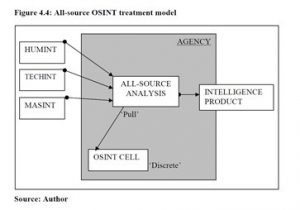
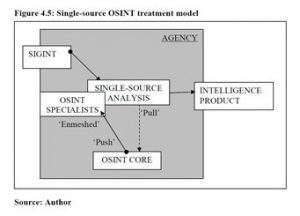 Below are four graphics in existence when Gibson did his thesis. The first is from Jan Herring, I created the second and fourth, Joe Markowitz created the third. Gibson's thesis is noteworthy for being lazy and lacking in breadth of authentic sources — he appears to have deliberately obscured and neglected my work knowing full well everything was available free online at the time, while badly harvesting from the 800 experts who spoke at my 20+ international conferences and whose work was easily available to Gibson free online at OSS.net at the time (today at https://phibetaota.net). .
Below are four graphics in existence when Gibson did his thesis. The first is from Jan Herring, I created the second and fourth, Joe Markowitz created the third. Gibson's thesis is noteworthy for being lazy and lacking in breadth of authentic sources — he appears to have deliberately obscured and neglected my work knowing full well everything was available free online at the time, while badly harvesting from the 800 experts who spoke at my 20+ international conferences and whose work was easily available to Gibson free online at OSS.net at the time (today at https://phibetaota.net). .
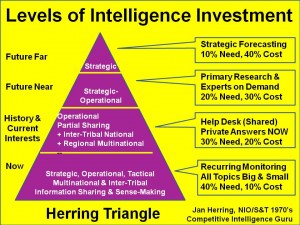
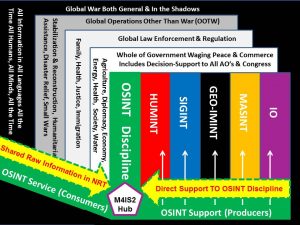

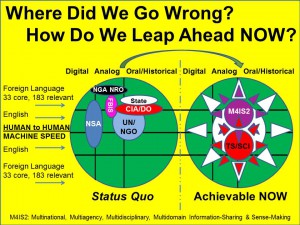
I struggled to find something of material value in Gibson's thesis, which I consider a very shallow endeavor lacking in a deep understanding of the threats, policies, demographics, and true costs against which OSINT is priceless to the commander and civilian customer.
Here is the one graphic is Gibson's work that I consider a moderately original contribution:
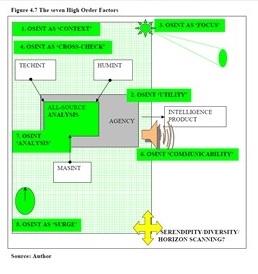 I do a better job in the below work circulated in draft in the US and UK in 2006, but let's give Gibson a tiny bit of credit.
I do a better job in the below work circulated in draft in the US and UK in 2006, but let's give Gibson a tiny bit of credit.
Steele, Robert. “Open Source Intelligence (Strategic),” in Loch Johnson (ed.), Strategic Intelligence: The Intelligence Cycle, Westport, CT: Praeger, 2007, Chapter 6, pp. 96-122.
You might also have a look at this overview and my original work on the value of OSINT overall as circulated in draft in the US and UK in 2006.
Steele, Robert. “The Evolving Craft of Intelligence,” in Robert Dover, Michael Goodman, and Claudia Hillebrand (eds.). Routledge Companion to Intelligence Studies, Oxford, UK: Routledge, July 31, 2013.
Steele, Robert. “Open Source Intelligence (Strategic),” in Loch Johnson (ed.), Strategic Intelligence: The Intelligence Cycle, Westport, CT: Praeger, 2007, Chapter 6, pp. 96-122.
Two more useful contextual works by others are here:
Review: No More Secrets – Open Source Information and the Reshaping of U.S. Intelligence
Review: Open Source Intelligence in a Networked World
And of course you should attend to the USDI material at the top of the below link, that includes the 2007 DoD briefings that General Michael Flynn has had in hand since 2014.
Smart Nation Vision – By Invitation
While now dated below is a partial sampling of the “pool” from which Mr. Gibson appears to have drawn the bulk of his “original” research — and of course he ignored everything that was not convenient to his shallow approach to a topic of vital national importance.
Search: bibliography for osint (new master list of archive link tables and directory entry points)
Below is my own curated list of particularly important contributions:
OSINT Historic Contributions Directory (List)
And here is a 2013 OSINT Literature Review of possible use to you.
OSINT Literature Review, Name Association, Lessons Learned
The briefing for Australia was one of my most comprehensive in the early days. My briefing for the Ministry of Defence in Denmark below in 2016 is my most recent overview. No country — particularly the UK and the US — are doing OSINT with intelligence or integrity.
Steele, Robert, “Royal Danish Defence College: Lecture by Robert Steele on Open Source Intelligence Done Right,” Copenhagen, Denmark: Royal Danish Defence College, April 18, 2016. OFFICIAL VIDEO 59 Minutes.
Steele, Robert. “Robert Steele on OSINT – Why and How,” Copenhagen, Denmark: Government of Denmark, April 18-20, 2016, as commissioned and presented to military, police, and national services. BRIEFING
The below three briefings are also useful for India:
Steele, Robert. “The Ultimate Hack – Resilient Villages, Smart Cities, Prosperous Nations at Peace — and Unlimited Clean Water,” Potomac, Maryland: Reserved, March 6, 2016, as discussed for transmission to the Government of India and others.
Steele, Robert. “Reflexivity as Integrity: Toward Earth/Life 4.0,” Washington, DC: Washington Academy of Sciences, March 31, 2012.
Steele, Robert. “The Ultimate Hack: Re-Inventing Intelligence to Re-Engineer Earth,” Odense, DK, October 27-28 2009. Simplified version; see March version for the longer engineering version.
SEE ALL
See Also:




